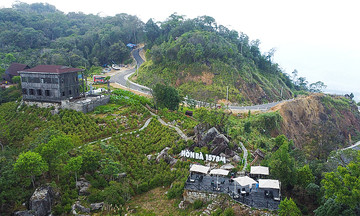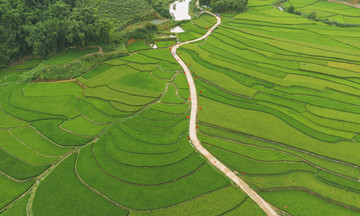Effective 1/7, Tay Ninh and Long An merged to form the new Tay Ninh province. This new province boasts a diverse network of destinations. Tay Ninh is famous for spiritual tourism, with Nui Ba Den, the Cao Dai Holy See, and Go Ken Pagoda attracting millions of domestic and international visitors. Long An is known for the Dong Thap Muoi wetlands ecosystem, melaleuca forests, and river culture. Previously, each locality operated its own tourism model. The merger allows these destinations to be combined into multi-regional tours, extending visitor stays and increasing spending.
MICE tourism, focusing on meetings, incentives, conferences, and exhibitions, can be developed at eco-resorts. Sports tourism, including running, cycling through melaleuca forests, and climbing Nui Ba Den, also opens niche markets for the region. Regional culinary tourism, combining Tay Ninh and Long An's specialties, has the potential to create unique tour brands.
 |
A corner of the "bay without waves" - Dau Tieng Lake in Tay Ninh. Photo: Huynh Phuong |
A corner of the "bay without waves" - Dau Tieng Lake in Tay Ninh. Photo: Huynh Phuong
The two former local governments launched a joint stimulus program in 2025. Long An initiated a tourism development stimulus program with support for promotion, service discounts, and the activation of a travel business alliance. Tay Ninh announced 4 major tourism projects, including a themed sightseeing and resort area on Nui Ba Den's peak and an eco-tourism complex combined with medical services. These projects are expected to complete their first phase by the end of 2025. Inter-provincial cooperation will attract major investors and high-end customers.
With the trend of green and smart tourism, the new Tay Ninh province is expected to develop further automated guide applications and digital maps integrating AR/VR experiences at historical sites. The community-based tourism model also promises increased income for rural residents.
Traditional craft village tourism in the new Tay Ninh province is considered a fertile ground. The province has dozens of traditional craft villages, including the Trang Bang rice paper village and the Binh An drum village. These spaces allow tourists to experience the steps involved in creating traditional products and learn about local culture.
 |
An elderly woman making conical hats in a Tay Ninh craft village. Photo: Huynh Phuong |
An elderly woman making conical hats in a Tay Ninh craft village. Photo: Huynh Phuong
To fully exploit these advantages, the Long An and (former) Tay Ninh Tourism Associations merged at the end of June. The association plays a connecting role, facilitating the development of tourism products that are well-organized and aligned with the strengths of each region. In the long term, the provincial Department of Culture, Sports, and Tourism expects the association to collaborate on a strategy for effective tourism development in Tay Ninh province during this new phase.
Transport infrastructure connecting the two former localities and Ho Chi Minh City will receive increased investment to create a unified development space. Highway 22 and the Ho Chi Minh City - Moc Bai Expressway are complete. Highway 1 has been upgraded and expanded. Ring Roads 3 and 4, connecting with the entire Southeast region, are under development. The province will also invest in inland waterway ports along several major rivers.
Connecting road and waterway networks will facilitate the development of agricultural tours combined with homestays. This linkage caters to the trend of green tourism, agricultural experiences, and exploring local culture.
The new Tay Ninh province benefits from its proximity to Ho Chi Minh City and the Southeast region, serving as a gateway to the Mekong Delta. Many experts believe this new tourism region has great potential. As a result, the local government is researching solutions to connect products, standardize service quality, and develop joint promotion programs.
Furthermore, after the merger, the province has the longest border with Cambodia, over 370 km, offering potential for cross-border tourism development. As transport infrastructure between the two countries improves, short tours through border gates and cross-border tourism models will open up prospects for attracting tourists.
According to local reports, during the first 6 months of the year (before the merger), Long An welcomed approximately 1.1 million visitors. Tay Ninh welcomed over 3.2 million visitors (data from the first 5 months).
Hoai Phuong












